Analysis of Urban Politics on Environmental Policy in New York City
VerifiedAdded on 2021/05/30
|10
|2654
|18
Report
AI Summary
This report provides an in-depth analysis of urban politics and environmental policy in New York City, focusing on the implementation and impact of the green building policy introduced in 2000. The paper examines the context of New York's environmental challenges, including increased population, greenhouse gas emissions, and pollution. It details the green building policy, its incentives, and the LEED standards used to evaluate building effectiveness. The report also explores the political debates surrounding the policy, including financial risks, legal standards, performance concerns, and the roles of consultants and contractors. The analysis contrasts proponent and opponent perspectives, highlighting legal protections for contractors and the positive impact of the policy on reducing greenhouse emissions. The study concludes that the green building policy is a critical component of the city's environmental agenda, influencing construction, financing, and development regulations. It emphasizes the importance of sustainable practices and the need for ongoing political efforts to address environmental issues, ultimately improving public health and contributing to global environmental goals.
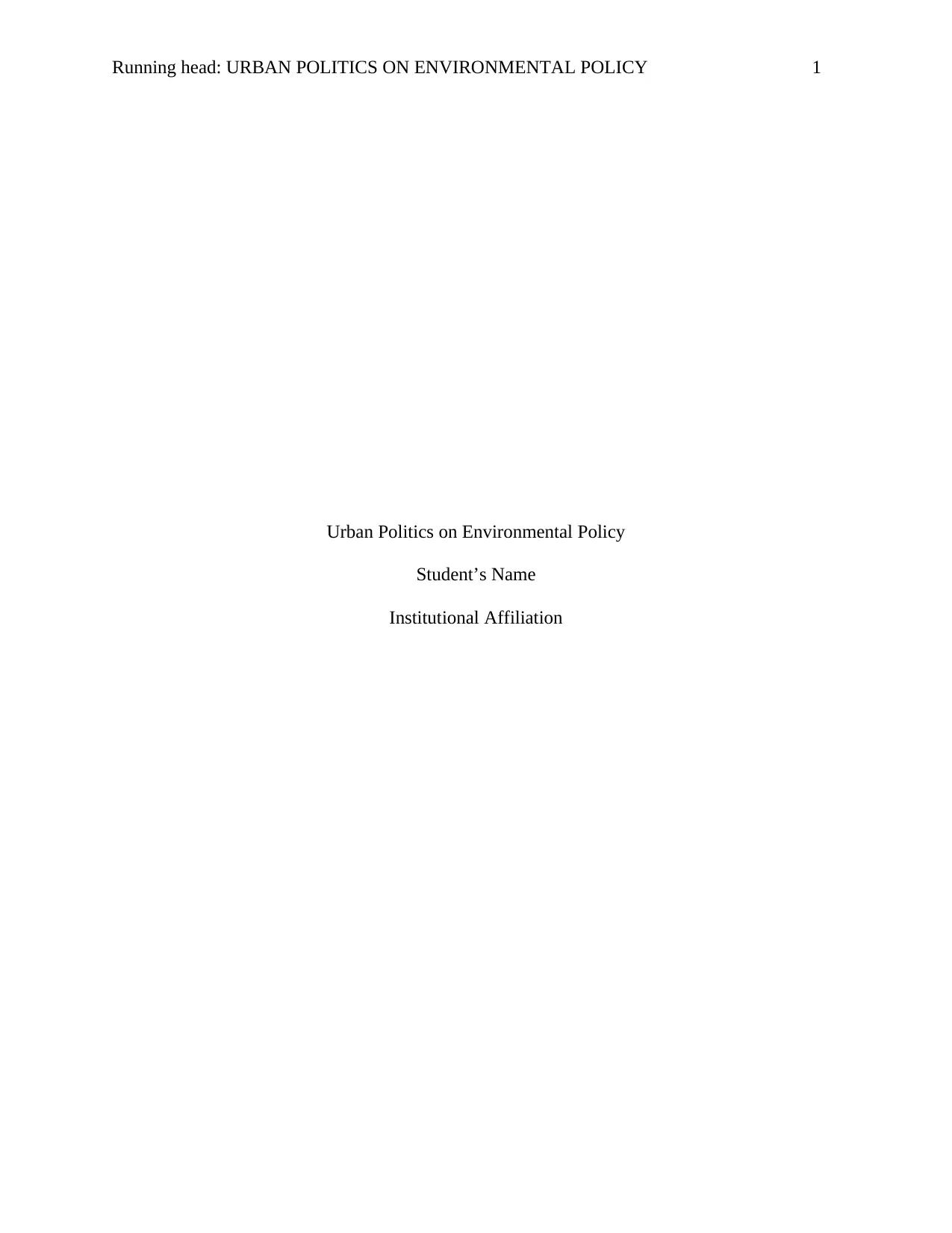
Running head: URBAN POLITICS ON ENVIRONMENTAL POLICY 1
Urban Politics on Environmental Policy
Student’s Name
Institutional Affiliation
Urban Politics on Environmental Policy
Student’s Name
Institutional Affiliation
Paraphrase This Document
Need a fresh take? Get an instant paraphrase of this document with our AI Paraphraser
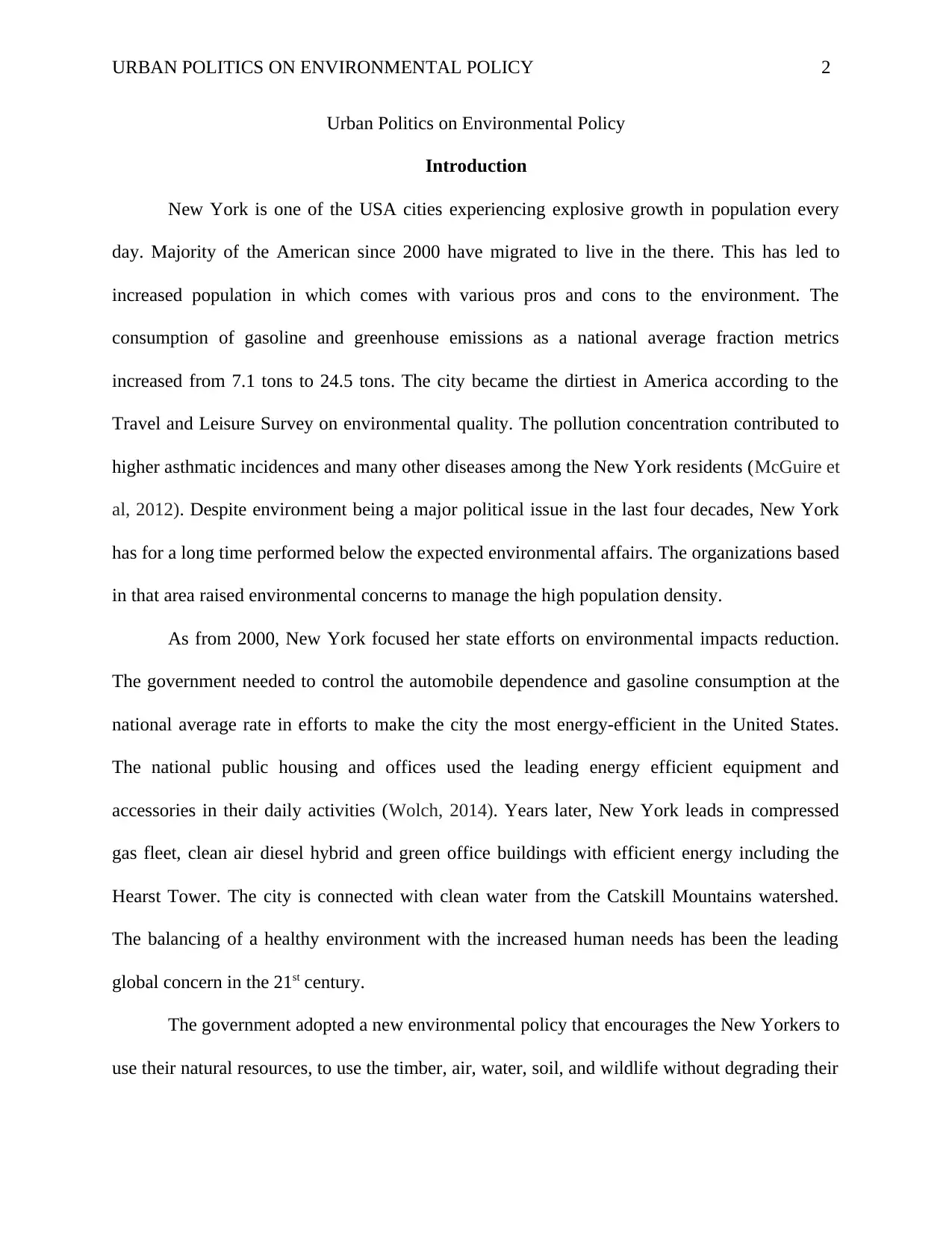
URBAN POLITICS ON ENVIRONMENTAL POLICY 2
Urban Politics on Environmental Policy
Introduction
New York is one of the USA cities experiencing explosive growth in population every
day. Majority of the American since 2000 have migrated to live in the there. This has led to
increased population in which comes with various pros and cons to the environment. The
consumption of gasoline and greenhouse emissions as a national average fraction metrics
increased from 7.1 tons to 24.5 tons. The city became the dirtiest in America according to the
Travel and Leisure Survey on environmental quality. The pollution concentration contributed to
higher asthmatic incidences and many other diseases among the New York residents (McGuire et
al, 2012). Despite environment being a major political issue in the last four decades, New York
has for a long time performed below the expected environmental affairs. The organizations based
in that area raised environmental concerns to manage the high population density.
As from 2000, New York focused her state efforts on environmental impacts reduction.
The government needed to control the automobile dependence and gasoline consumption at the
national average rate in efforts to make the city the most energy-efficient in the United States.
The national public housing and offices used the leading energy efficient equipment and
accessories in their daily activities (Wolch, 2014). Years later, New York leads in compressed
gas fleet, clean air diesel hybrid and green office buildings with efficient energy including the
Hearst Tower. The city is connected with clean water from the Catskill Mountains watershed.
The balancing of a healthy environment with the increased human needs has been the leading
global concern in the 21st century.
The government adopted a new environmental policy that encourages the New Yorkers to
use their natural resources, to use the timber, air, water, soil, and wildlife without degrading their
Urban Politics on Environmental Policy
Introduction
New York is one of the USA cities experiencing explosive growth in population every
day. Majority of the American since 2000 have migrated to live in the there. This has led to
increased population in which comes with various pros and cons to the environment. The
consumption of gasoline and greenhouse emissions as a national average fraction metrics
increased from 7.1 tons to 24.5 tons. The city became the dirtiest in America according to the
Travel and Leisure Survey on environmental quality. The pollution concentration contributed to
higher asthmatic incidences and many other diseases among the New York residents (McGuire et
al, 2012). Despite environment being a major political issue in the last four decades, New York
has for a long time performed below the expected environmental affairs. The organizations based
in that area raised environmental concerns to manage the high population density.
As from 2000, New York focused her state efforts on environmental impacts reduction.
The government needed to control the automobile dependence and gasoline consumption at the
national average rate in efforts to make the city the most energy-efficient in the United States.
The national public housing and offices used the leading energy efficient equipment and
accessories in their daily activities (Wolch, 2014). Years later, New York leads in compressed
gas fleet, clean air diesel hybrid and green office buildings with efficient energy including the
Hearst Tower. The city is connected with clean water from the Catskill Mountains watershed.
The balancing of a healthy environment with the increased human needs has been the leading
global concern in the 21st century.
The government adopted a new environmental policy that encourages the New Yorkers to
use their natural resources, to use the timber, air, water, soil, and wildlife without degrading their
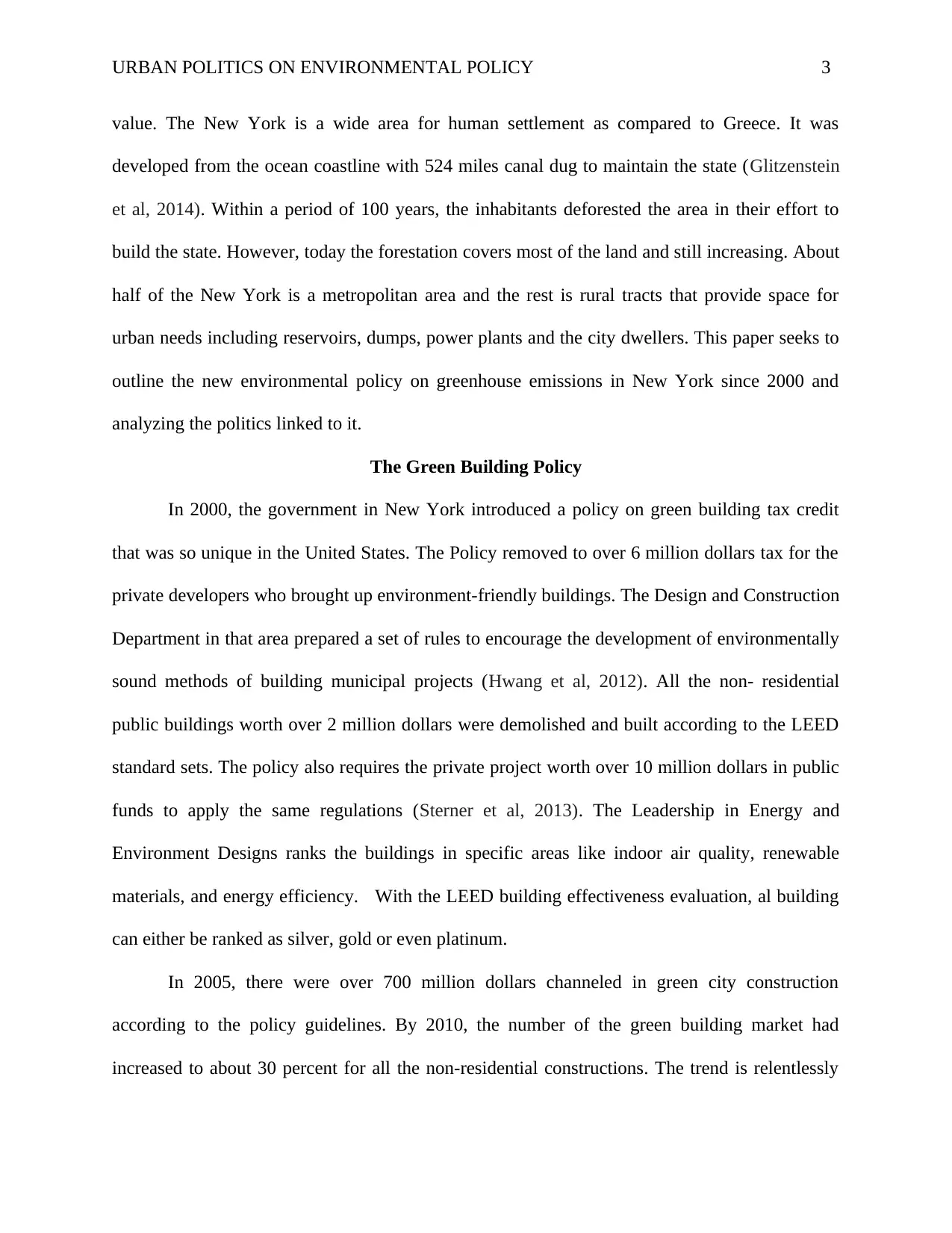
URBAN POLITICS ON ENVIRONMENTAL POLICY 3
value. The New York is a wide area for human settlement as compared to Greece. It was
developed from the ocean coastline with 524 miles canal dug to maintain the state (Glitzenstein
et al, 2014). Within a period of 100 years, the inhabitants deforested the area in their effort to
build the state. However, today the forestation covers most of the land and still increasing. About
half of the New York is a metropolitan area and the rest is rural tracts that provide space for
urban needs including reservoirs, dumps, power plants and the city dwellers. This paper seeks to
outline the new environmental policy on greenhouse emissions in New York since 2000 and
analyzing the politics linked to it.
The Green Building Policy
In 2000, the government in New York introduced a policy on green building tax credit
that was so unique in the United States. The Policy removed to over 6 million dollars tax for the
private developers who brought up environment-friendly buildings. The Design and Construction
Department in that area prepared a set of rules to encourage the development of environmentally
sound methods of building municipal projects (Hwang et al, 2012). All the non- residential
public buildings worth over 2 million dollars were demolished and built according to the LEED
standard sets. The policy also requires the private project worth over 10 million dollars in public
funds to apply the same regulations (Sterner et al, 2013). The Leadership in Energy and
Environment Designs ranks the buildings in specific areas like indoor air quality, renewable
materials, and energy efficiency. With the LEED building effectiveness evaluation, al building
can either be ranked as silver, gold or even platinum.
In 2005, there were over 700 million dollars channeled in green city construction
according to the policy guidelines. By 2010, the number of the green building market had
increased to about 30 percent for all the non-residential constructions. The trend is relentlessly
value. The New York is a wide area for human settlement as compared to Greece. It was
developed from the ocean coastline with 524 miles canal dug to maintain the state (Glitzenstein
et al, 2014). Within a period of 100 years, the inhabitants deforested the area in their effort to
build the state. However, today the forestation covers most of the land and still increasing. About
half of the New York is a metropolitan area and the rest is rural tracts that provide space for
urban needs including reservoirs, dumps, power plants and the city dwellers. This paper seeks to
outline the new environmental policy on greenhouse emissions in New York since 2000 and
analyzing the politics linked to it.
The Green Building Policy
In 2000, the government in New York introduced a policy on green building tax credit
that was so unique in the United States. The Policy removed to over 6 million dollars tax for the
private developers who brought up environment-friendly buildings. The Design and Construction
Department in that area prepared a set of rules to encourage the development of environmentally
sound methods of building municipal projects (Hwang et al, 2012). All the non- residential
public buildings worth over 2 million dollars were demolished and built according to the LEED
standard sets. The policy also requires the private project worth over 10 million dollars in public
funds to apply the same regulations (Sterner et al, 2013). The Leadership in Energy and
Environment Designs ranks the buildings in specific areas like indoor air quality, renewable
materials, and energy efficiency. With the LEED building effectiveness evaluation, al building
can either be ranked as silver, gold or even platinum.
In 2005, there were over 700 million dollars channeled in green city construction
according to the policy guidelines. By 2010, the number of the green building market had
increased to about 30 percent for all the non-residential constructions. The trend is relentlessly
⊘ This is a preview!⊘
Do you want full access?
Subscribe today to unlock all pages.

Trusted by 1+ million students worldwide
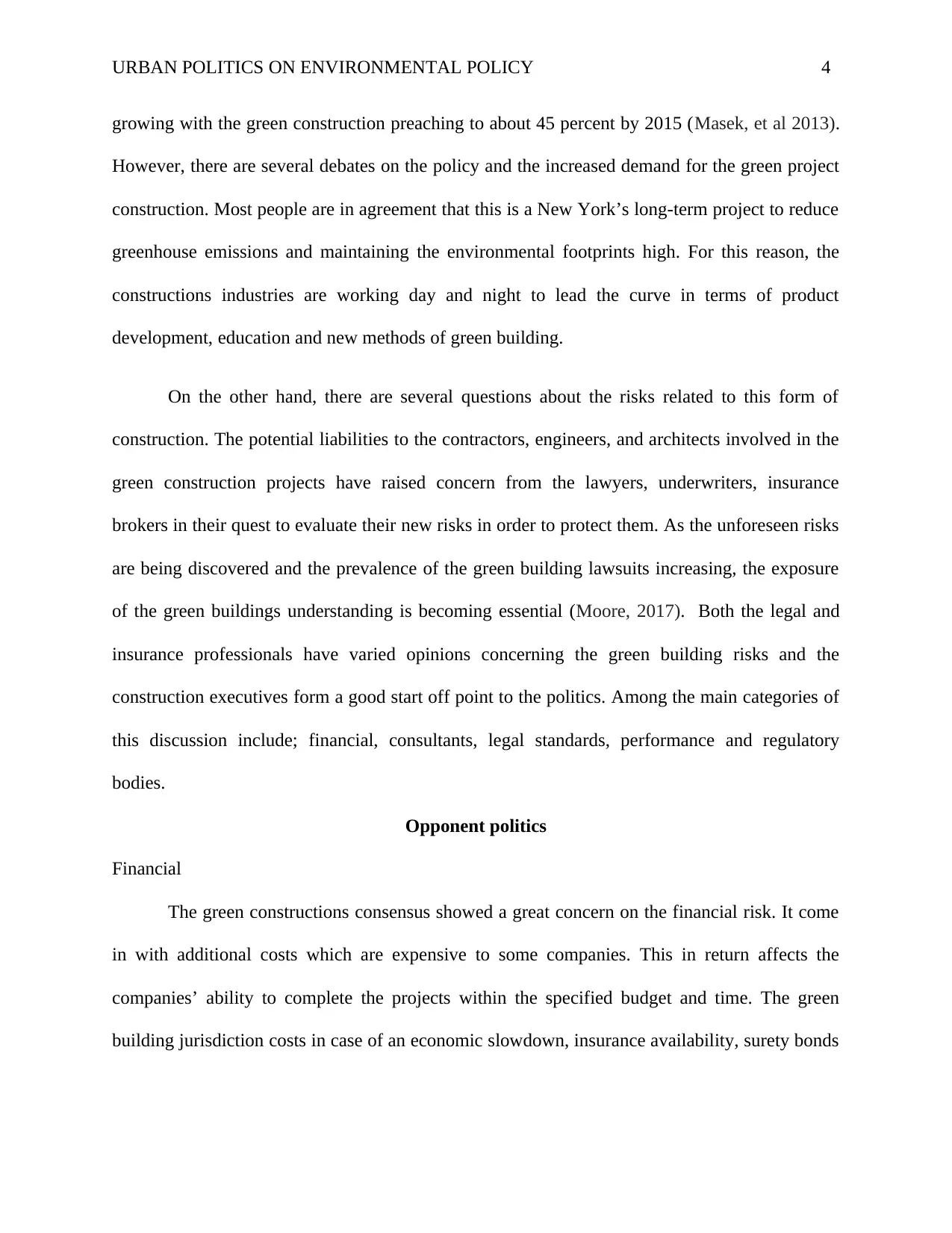
URBAN POLITICS ON ENVIRONMENTAL POLICY 4
growing with the green construction preaching to about 45 percent by 2015 (Masek, et al 2013).
However, there are several debates on the policy and the increased demand for the green project
construction. Most people are in agreement that this is a New York’s long-term project to reduce
greenhouse emissions and maintaining the environmental footprints high. For this reason, the
constructions industries are working day and night to lead the curve in terms of product
development, education and new methods of green building.
On the other hand, there are several questions about the risks related to this form of
construction. The potential liabilities to the contractors, engineers, and architects involved in the
green construction projects have raised concern from the lawyers, underwriters, insurance
brokers in their quest to evaluate their new risks in order to protect them. As the unforeseen risks
are being discovered and the prevalence of the green building lawsuits increasing, the exposure
of the green buildings understanding is becoming essential (Moore, 2017). Both the legal and
insurance professionals have varied opinions concerning the green building risks and the
construction executives form a good start off point to the politics. Among the main categories of
this discussion include; financial, consultants, legal standards, performance and regulatory
bodies.
Opponent politics
Financial
The green constructions consensus showed a great concern on the financial risk. It come
in with additional costs which are expensive to some companies. This in return affects the
companies’ ability to complete the projects within the specified budget and time. The green
building jurisdiction costs in case of an economic slowdown, insurance availability, surety bonds
growing with the green construction preaching to about 45 percent by 2015 (Masek, et al 2013).
However, there are several debates on the policy and the increased demand for the green project
construction. Most people are in agreement that this is a New York’s long-term project to reduce
greenhouse emissions and maintaining the environmental footprints high. For this reason, the
constructions industries are working day and night to lead the curve in terms of product
development, education and new methods of green building.
On the other hand, there are several questions about the risks related to this form of
construction. The potential liabilities to the contractors, engineers, and architects involved in the
green construction projects have raised concern from the lawyers, underwriters, insurance
brokers in their quest to evaluate their new risks in order to protect them. As the unforeseen risks
are being discovered and the prevalence of the green building lawsuits increasing, the exposure
of the green buildings understanding is becoming essential (Moore, 2017). Both the legal and
insurance professionals have varied opinions concerning the green building risks and the
construction executives form a good start off point to the politics. Among the main categories of
this discussion include; financial, consultants, legal standards, performance and regulatory
bodies.
Opponent politics
Financial
The green constructions consensus showed a great concern on the financial risk. It come
in with additional costs which are expensive to some companies. This in return affects the
companies’ ability to complete the projects within the specified budget and time. The green
building jurisdiction costs in case of an economic slowdown, insurance availability, surety bonds
Paraphrase This Document
Need a fresh take? Get an instant paraphrase of this document with our AI Paraphraser
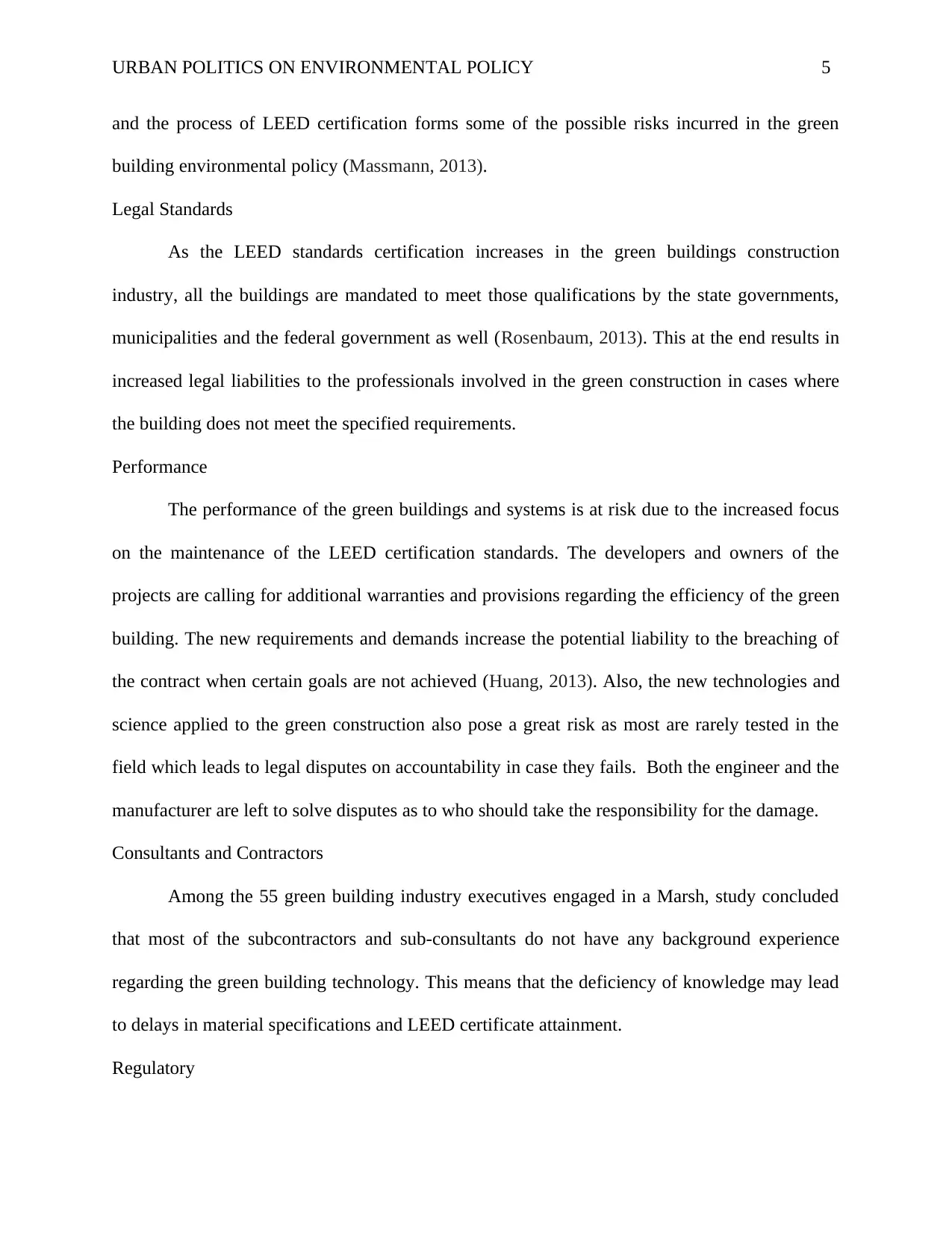
URBAN POLITICS ON ENVIRONMENTAL POLICY 5
and the process of LEED certification forms some of the possible risks incurred in the green
building environmental policy (Massmann, 2013).
Legal Standards
As the LEED standards certification increases in the green buildings construction
industry, all the buildings are mandated to meet those qualifications by the state governments,
municipalities and the federal government as well (Rosenbaum, 2013). This at the end results in
increased legal liabilities to the professionals involved in the green construction in cases where
the building does not meet the specified requirements.
Performance
The performance of the green buildings and systems is at risk due to the increased focus
on the maintenance of the LEED certification standards. The developers and owners of the
projects are calling for additional warranties and provisions regarding the efficiency of the green
building. The new requirements and demands increase the potential liability to the breaching of
the contract when certain goals are not achieved (Huang, 2013). Also, the new technologies and
science applied to the green construction also pose a great risk as most are rarely tested in the
field which leads to legal disputes on accountability in case they fails. Both the engineer and the
manufacturer are left to solve disputes as to who should take the responsibility for the damage.
Consultants and Contractors
Among the 55 green building industry executives engaged in a Marsh, study concluded
that most of the subcontractors and sub-consultants do not have any background experience
regarding the green building technology. This means that the deficiency of knowledge may lead
to delays in material specifications and LEED certificate attainment.
Regulatory
and the process of LEED certification forms some of the possible risks incurred in the green
building environmental policy (Massmann, 2013).
Legal Standards
As the LEED standards certification increases in the green buildings construction
industry, all the buildings are mandated to meet those qualifications by the state governments,
municipalities and the federal government as well (Rosenbaum, 2013). This at the end results in
increased legal liabilities to the professionals involved in the green construction in cases where
the building does not meet the specified requirements.
Performance
The performance of the green buildings and systems is at risk due to the increased focus
on the maintenance of the LEED certification standards. The developers and owners of the
projects are calling for additional warranties and provisions regarding the efficiency of the green
building. The new requirements and demands increase the potential liability to the breaching of
the contract when certain goals are not achieved (Huang, 2013). Also, the new technologies and
science applied to the green construction also pose a great risk as most are rarely tested in the
field which leads to legal disputes on accountability in case they fails. Both the engineer and the
manufacturer are left to solve disputes as to who should take the responsibility for the damage.
Consultants and Contractors
Among the 55 green building industry executives engaged in a Marsh, study concluded
that most of the subcontractors and sub-consultants do not have any background experience
regarding the green building technology. This means that the deficiency of knowledge may lead
to delays in material specifications and LEED certificate attainment.
Regulatory
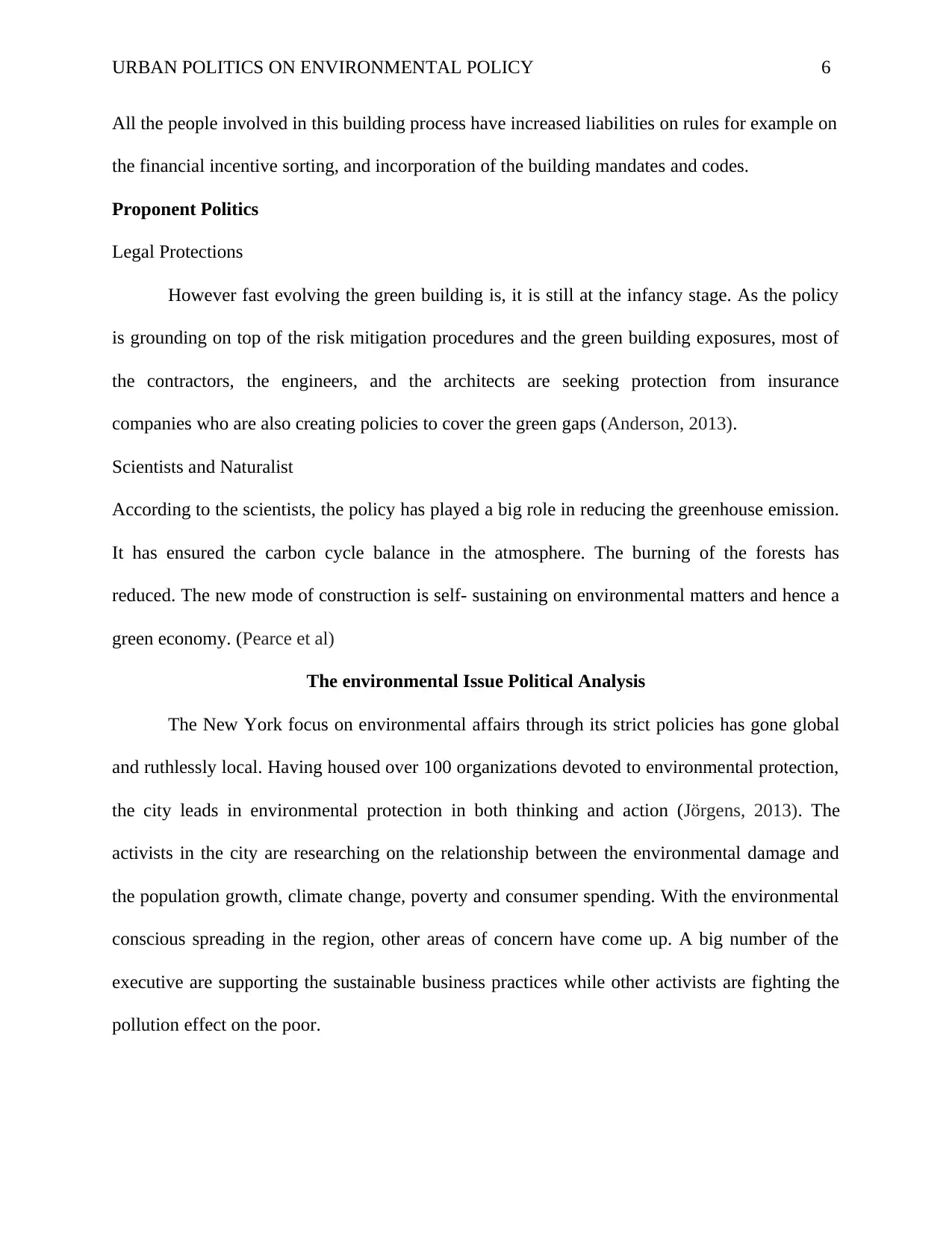
URBAN POLITICS ON ENVIRONMENTAL POLICY 6
All the people involved in this building process have increased liabilities on rules for example on
the financial incentive sorting, and incorporation of the building mandates and codes.
Proponent Politics
Legal Protections
However fast evolving the green building is, it is still at the infancy stage. As the policy
is grounding on top of the risk mitigation procedures and the green building exposures, most of
the contractors, the engineers, and the architects are seeking protection from insurance
companies who are also creating policies to cover the green gaps (Anderson, 2013).
Scientists and Naturalist
According to the scientists, the policy has played a big role in reducing the greenhouse emission.
It has ensured the carbon cycle balance in the atmosphere. The burning of the forests has
reduced. The new mode of construction is self- sustaining on environmental matters and hence a
green economy. (Pearce et al)
The environmental Issue Political Analysis
The New York focus on environmental affairs through its strict policies has gone global
and ruthlessly local. Having housed over 100 organizations devoted to environmental protection,
the city leads in environmental protection in both thinking and action (Jörgens, 2013). The
activists in the city are researching on the relationship between the environmental damage and
the population growth, climate change, poverty and consumer spending. With the environmental
conscious spreading in the region, other areas of concern have come up. A big number of the
executive are supporting the sustainable business practices while other activists are fighting the
pollution effect on the poor.
All the people involved in this building process have increased liabilities on rules for example on
the financial incentive sorting, and incorporation of the building mandates and codes.
Proponent Politics
Legal Protections
However fast evolving the green building is, it is still at the infancy stage. As the policy
is grounding on top of the risk mitigation procedures and the green building exposures, most of
the contractors, the engineers, and the architects are seeking protection from insurance
companies who are also creating policies to cover the green gaps (Anderson, 2013).
Scientists and Naturalist
According to the scientists, the policy has played a big role in reducing the greenhouse emission.
It has ensured the carbon cycle balance in the atmosphere. The burning of the forests has
reduced. The new mode of construction is self- sustaining on environmental matters and hence a
green economy. (Pearce et al)
The environmental Issue Political Analysis
The New York focus on environmental affairs through its strict policies has gone global
and ruthlessly local. Having housed over 100 organizations devoted to environmental protection,
the city leads in environmental protection in both thinking and action (Jörgens, 2013). The
activists in the city are researching on the relationship between the environmental damage and
the population growth, climate change, poverty and consumer spending. With the environmental
conscious spreading in the region, other areas of concern have come up. A big number of the
executive are supporting the sustainable business practices while other activists are fighting the
pollution effect on the poor.
⊘ This is a preview!⊘
Do you want full access?
Subscribe today to unlock all pages.

Trusted by 1+ million students worldwide
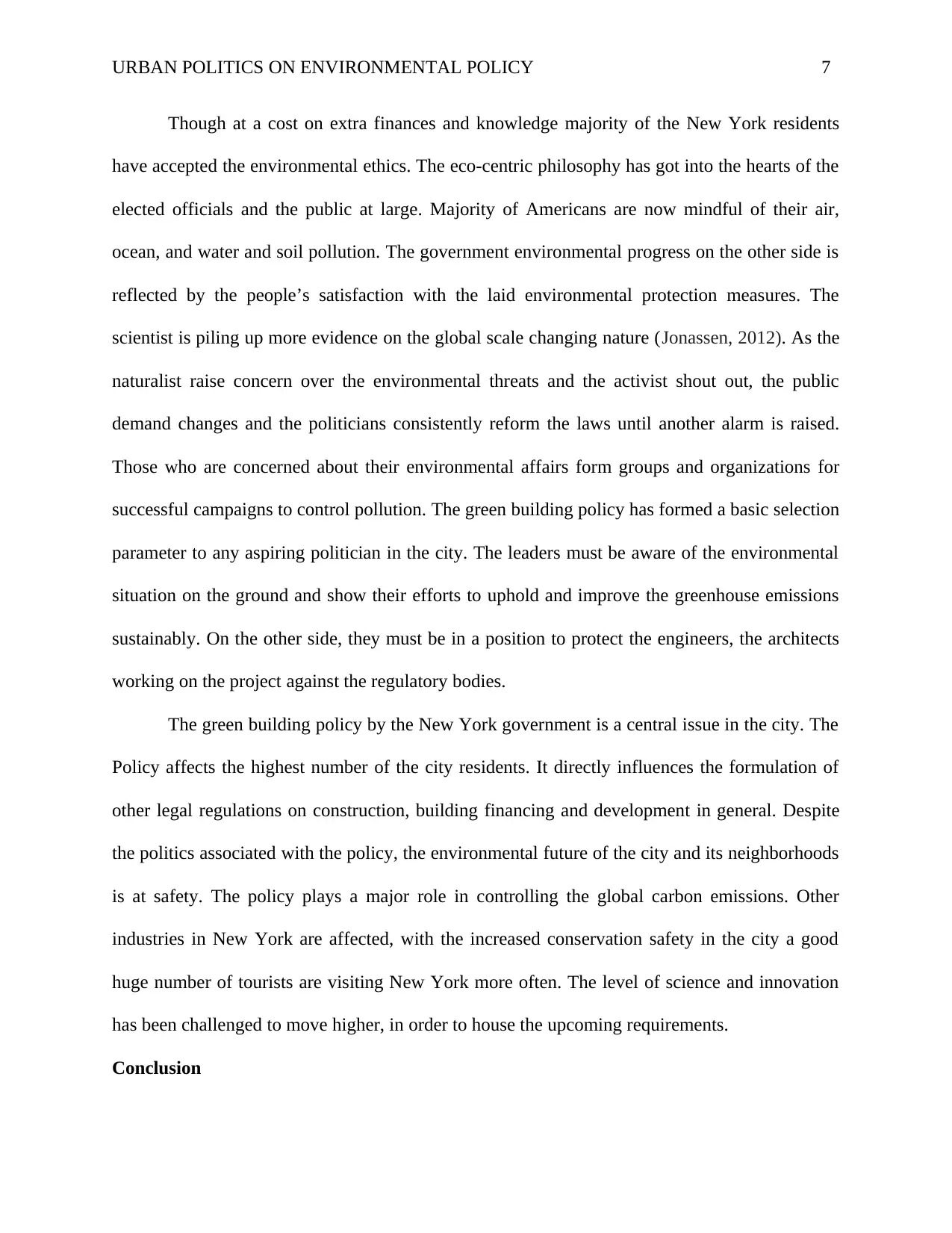
URBAN POLITICS ON ENVIRONMENTAL POLICY 7
Though at a cost on extra finances and knowledge majority of the New York residents
have accepted the environmental ethics. The eco-centric philosophy has got into the hearts of the
elected officials and the public at large. Majority of Americans are now mindful of their air,
ocean, and water and soil pollution. The government environmental progress on the other side is
reflected by the people’s satisfaction with the laid environmental protection measures. The
scientist is piling up more evidence on the global scale changing nature (Jonassen, 2012). As the
naturalist raise concern over the environmental threats and the activist shout out, the public
demand changes and the politicians consistently reform the laws until another alarm is raised.
Those who are concerned about their environmental affairs form groups and organizations for
successful campaigns to control pollution. The green building policy has formed a basic selection
parameter to any aspiring politician in the city. The leaders must be aware of the environmental
situation on the ground and show their efforts to uphold and improve the greenhouse emissions
sustainably. On the other side, they must be in a position to protect the engineers, the architects
working on the project against the regulatory bodies.
The green building policy by the New York government is a central issue in the city. The
Policy affects the highest number of the city residents. It directly influences the formulation of
other legal regulations on construction, building financing and development in general. Despite
the politics associated with the policy, the environmental future of the city and its neighborhoods
is at safety. The policy plays a major role in controlling the global carbon emissions. Other
industries in New York are affected, with the increased conservation safety in the city a good
huge number of tourists are visiting New York more often. The level of science and innovation
has been challenged to move higher, in order to house the upcoming requirements.
Conclusion
Though at a cost on extra finances and knowledge majority of the New York residents
have accepted the environmental ethics. The eco-centric philosophy has got into the hearts of the
elected officials and the public at large. Majority of Americans are now mindful of their air,
ocean, and water and soil pollution. The government environmental progress on the other side is
reflected by the people’s satisfaction with the laid environmental protection measures. The
scientist is piling up more evidence on the global scale changing nature (Jonassen, 2012). As the
naturalist raise concern over the environmental threats and the activist shout out, the public
demand changes and the politicians consistently reform the laws until another alarm is raised.
Those who are concerned about their environmental affairs form groups and organizations for
successful campaigns to control pollution. The green building policy has formed a basic selection
parameter to any aspiring politician in the city. The leaders must be aware of the environmental
situation on the ground and show their efforts to uphold and improve the greenhouse emissions
sustainably. On the other side, they must be in a position to protect the engineers, the architects
working on the project against the regulatory bodies.
The green building policy by the New York government is a central issue in the city. The
Policy affects the highest number of the city residents. It directly influences the formulation of
other legal regulations on construction, building financing and development in general. Despite
the politics associated with the policy, the environmental future of the city and its neighborhoods
is at safety. The policy plays a major role in controlling the global carbon emissions. Other
industries in New York are affected, with the increased conservation safety in the city a good
huge number of tourists are visiting New York more often. The level of science and innovation
has been challenged to move higher, in order to house the upcoming requirements.
Conclusion
Paraphrase This Document
Need a fresh take? Get an instant paraphrase of this document with our AI Paraphraser
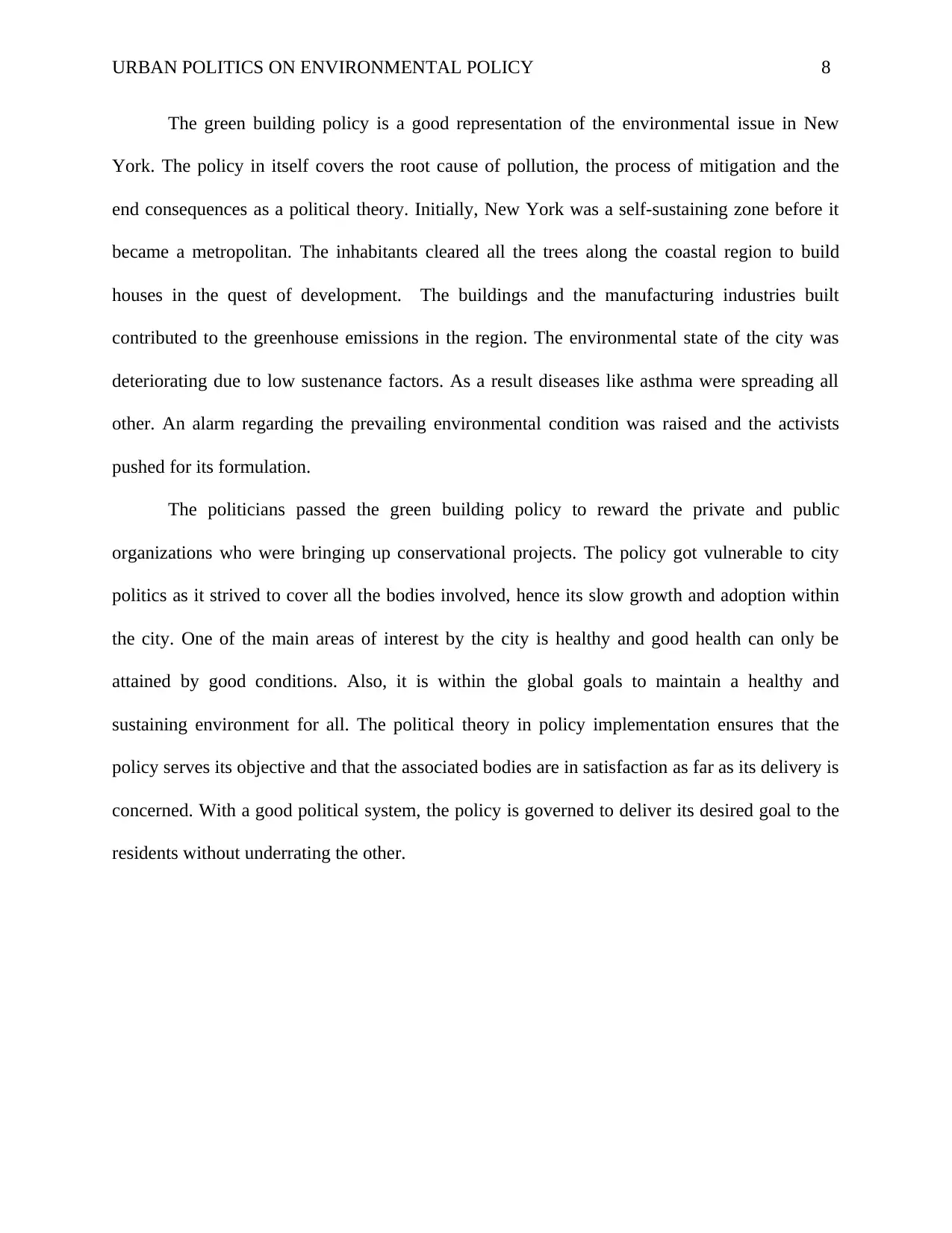
URBAN POLITICS ON ENVIRONMENTAL POLICY 8
The green building policy is a good representation of the environmental issue in New
York. The policy in itself covers the root cause of pollution, the process of mitigation and the
end consequences as a political theory. Initially, New York was a self-sustaining zone before it
became a metropolitan. The inhabitants cleared all the trees along the coastal region to build
houses in the quest of development. The buildings and the manufacturing industries built
contributed to the greenhouse emissions in the region. The environmental state of the city was
deteriorating due to low sustenance factors. As a result diseases like asthma were spreading all
other. An alarm regarding the prevailing environmental condition was raised and the activists
pushed for its formulation.
The politicians passed the green building policy to reward the private and public
organizations who were bringing up conservational projects. The policy got vulnerable to city
politics as it strived to cover all the bodies involved, hence its slow growth and adoption within
the city. One of the main areas of interest by the city is healthy and good health can only be
attained by good conditions. Also, it is within the global goals to maintain a healthy and
sustaining environment for all. The political theory in policy implementation ensures that the
policy serves its objective and that the associated bodies are in satisfaction as far as its delivery is
concerned. With a good political system, the policy is governed to deliver its desired goal to the
residents without underrating the other.
The green building policy is a good representation of the environmental issue in New
York. The policy in itself covers the root cause of pollution, the process of mitigation and the
end consequences as a political theory. Initially, New York was a self-sustaining zone before it
became a metropolitan. The inhabitants cleared all the trees along the coastal region to build
houses in the quest of development. The buildings and the manufacturing industries built
contributed to the greenhouse emissions in the region. The environmental state of the city was
deteriorating due to low sustenance factors. As a result diseases like asthma were spreading all
other. An alarm regarding the prevailing environmental condition was raised and the activists
pushed for its formulation.
The politicians passed the green building policy to reward the private and public
organizations who were bringing up conservational projects. The policy got vulnerable to city
politics as it strived to cover all the bodies involved, hence its slow growth and adoption within
the city. One of the main areas of interest by the city is healthy and good health can only be
attained by good conditions. Also, it is within the global goals to maintain a healthy and
sustaining environment for all. The political theory in policy implementation ensures that the
policy serves its objective and that the associated bodies are in satisfaction as far as its delivery is
concerned. With a good political system, the policy is governed to deliver its desired goal to the
residents without underrating the other.
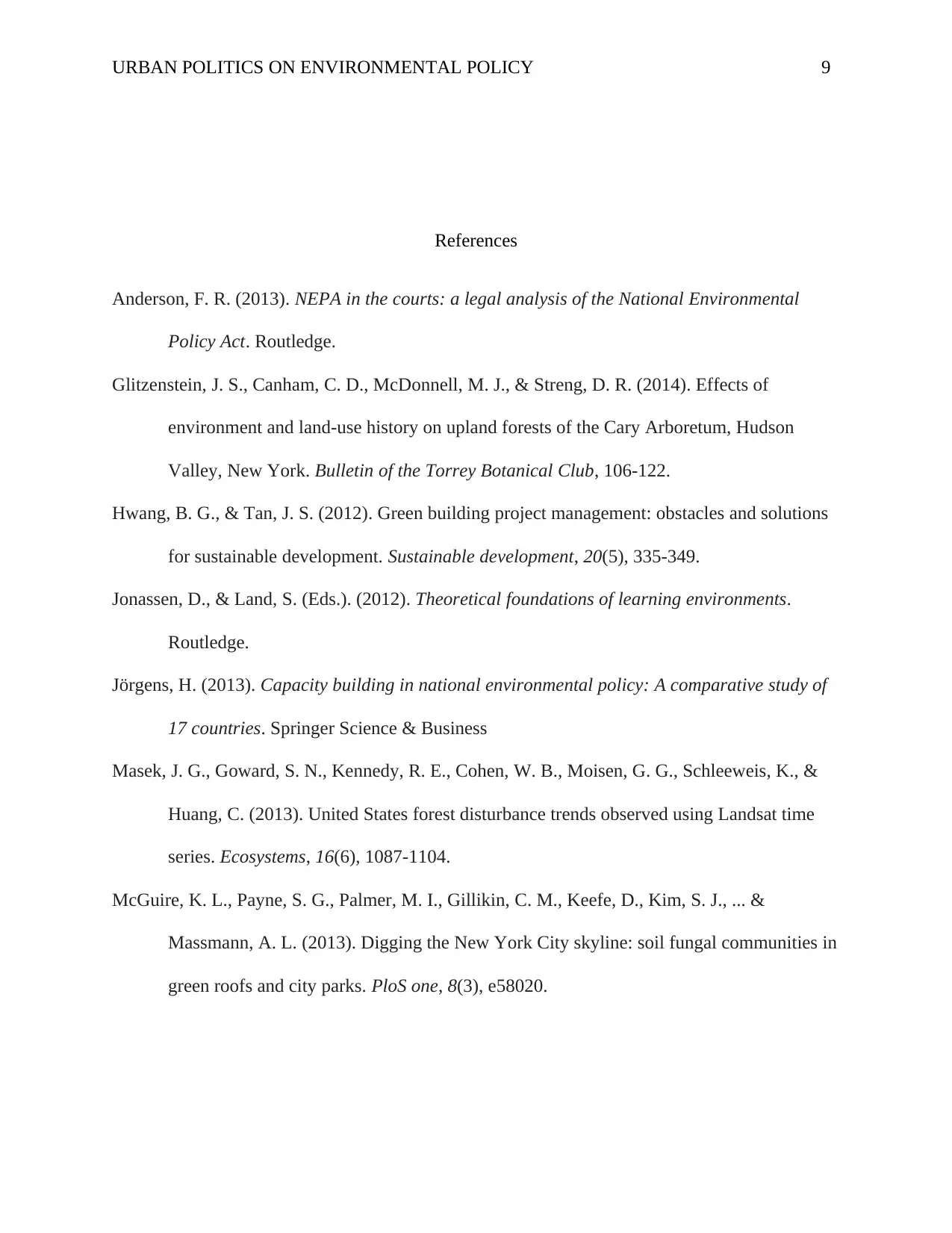
URBAN POLITICS ON ENVIRONMENTAL POLICY 9
References
Anderson, F. R. (2013). NEPA in the courts: a legal analysis of the National Environmental
Policy Act. Routledge.
Glitzenstein, J. S., Canham, C. D., McDonnell, M. J., & Streng, D. R. (2014). Effects of
environment and land-use history on upland forests of the Cary Arboretum, Hudson
Valley, New York. Bulletin of the Torrey Botanical Club, 106-122.
Hwang, B. G., & Tan, J. S. (2012). Green building project management: obstacles and solutions
for sustainable development. Sustainable development, 20(5), 335-349.
Jonassen, D., & Land, S. (Eds.). (2012). Theoretical foundations of learning environments.
Routledge.
Jörgens, H. (2013). Capacity building in national environmental policy: A comparative study of
17 countries. Springer Science & Business
Masek, J. G., Goward, S. N., Kennedy, R. E., Cohen, W. B., Moisen, G. G., Schleeweis, K., &
Huang, C. (2013). United States forest disturbance trends observed using Landsat time
series. Ecosystems, 16(6), 1087-1104.
McGuire, K. L., Payne, S. G., Palmer, M. I., Gillikin, C. M., Keefe, D., Kim, S. J., ... &
Massmann, A. L. (2013). Digging the New York City skyline: soil fungal communities in
green roofs and city parks. PloS one, 8(3), e58020.
References
Anderson, F. R. (2013). NEPA in the courts: a legal analysis of the National Environmental
Policy Act. Routledge.
Glitzenstein, J. S., Canham, C. D., McDonnell, M. J., & Streng, D. R. (2014). Effects of
environment and land-use history on upland forests of the Cary Arboretum, Hudson
Valley, New York. Bulletin of the Torrey Botanical Club, 106-122.
Hwang, B. G., & Tan, J. S. (2012). Green building project management: obstacles and solutions
for sustainable development. Sustainable development, 20(5), 335-349.
Jonassen, D., & Land, S. (Eds.). (2012). Theoretical foundations of learning environments.
Routledge.
Jörgens, H. (2013). Capacity building in national environmental policy: A comparative study of
17 countries. Springer Science & Business
Masek, J. G., Goward, S. N., Kennedy, R. E., Cohen, W. B., Moisen, G. G., Schleeweis, K., &
Huang, C. (2013). United States forest disturbance trends observed using Landsat time
series. Ecosystems, 16(6), 1087-1104.
McGuire, K. L., Payne, S. G., Palmer, M. I., Gillikin, C. M., Keefe, D., Kim, S. J., ... &
Massmann, A. L. (2013). Digging the New York City skyline: soil fungal communities in
green roofs and city parks. PloS one, 8(3), e58020.
⊘ This is a preview!⊘
Do you want full access?
Subscribe today to unlock all pages.

Trusted by 1+ million students worldwide
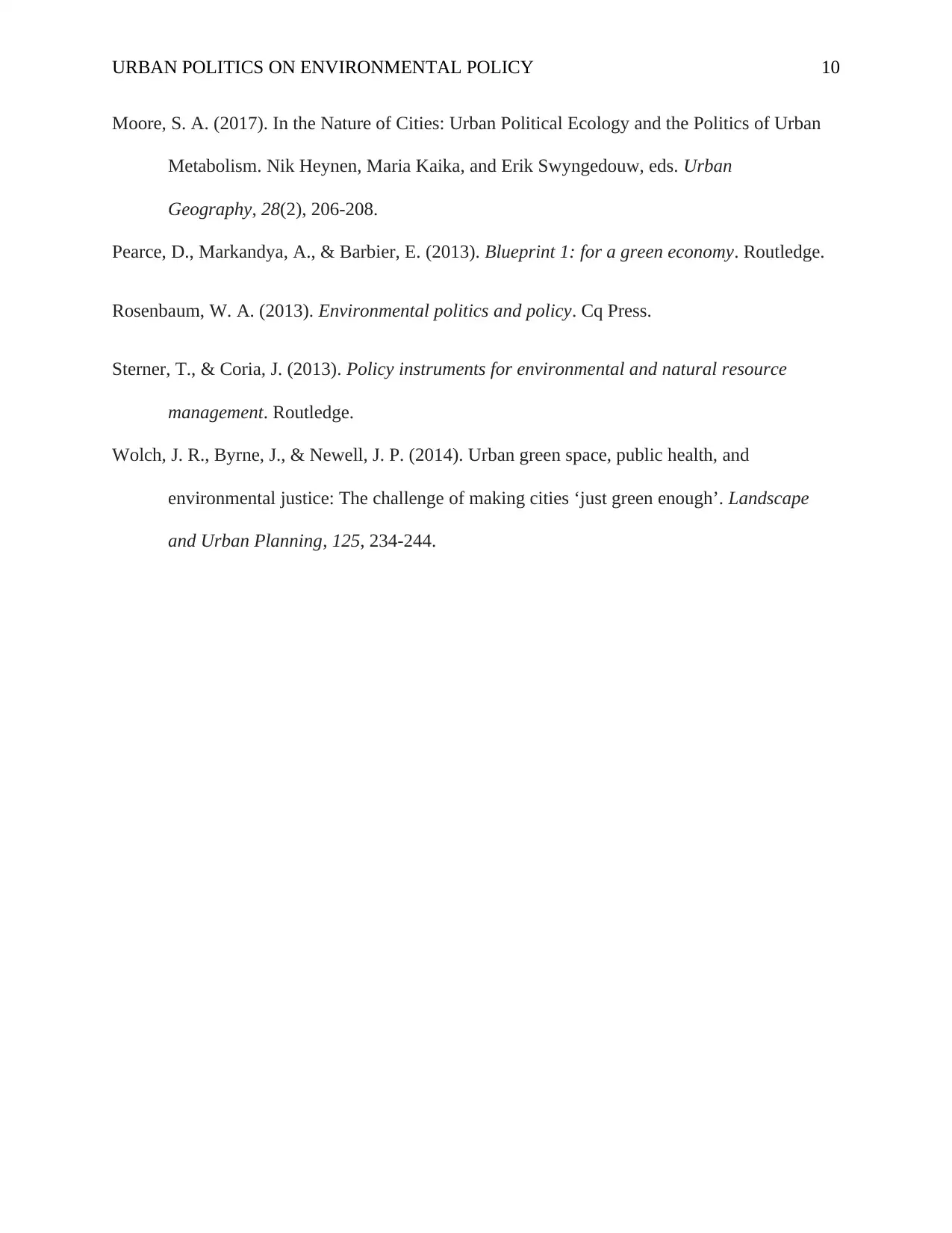
URBAN POLITICS ON ENVIRONMENTAL POLICY 10
Moore, S. A. (2017). In the Nature of Cities: Urban Political Ecology and the Politics of Urban
Metabolism. Nik Heynen, Maria Kaika, and Erik Swyngedouw, eds. Urban
Geography, 28(2), 206-208.
Pearce, D., Markandya, A., & Barbier, E. (2013). Blueprint 1: for a green economy. Routledge.
Rosenbaum, W. A. (2013). Environmental politics and policy. Cq Press.
Sterner, T., & Coria, J. (2013). Policy instruments for environmental and natural resource
management. Routledge.
Wolch, J. R., Byrne, J., & Newell, J. P. (2014). Urban green space, public health, and
environmental justice: The challenge of making cities ‘just green enough’. Landscape
and Urban Planning, 125, 234-244.
Moore, S. A. (2017). In the Nature of Cities: Urban Political Ecology and the Politics of Urban
Metabolism. Nik Heynen, Maria Kaika, and Erik Swyngedouw, eds. Urban
Geography, 28(2), 206-208.
Pearce, D., Markandya, A., & Barbier, E. (2013). Blueprint 1: for a green economy. Routledge.
Rosenbaum, W. A. (2013). Environmental politics and policy. Cq Press.
Sterner, T., & Coria, J. (2013). Policy instruments for environmental and natural resource
management. Routledge.
Wolch, J. R., Byrne, J., & Newell, J. P. (2014). Urban green space, public health, and
environmental justice: The challenge of making cities ‘just green enough’. Landscape
and Urban Planning, 125, 234-244.
1 out of 10
Related Documents
Your All-in-One AI-Powered Toolkit for Academic Success.
+13062052269
info@desklib.com
Available 24*7 on WhatsApp / Email
![[object Object]](/_next/static/media/star-bottom.7253800d.svg)
Unlock your academic potential
Copyright © 2020–2025 A2Z Services. All Rights Reserved. Developed and managed by ZUCOL.




